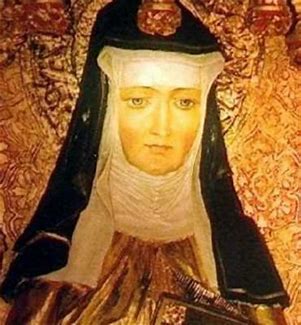
SEPTEMBER 17 is the traditional memorial of ST. HILDEGARD (+1179).
Hildegard was born around 1098 in the western part of Germany. Her father, Metchuld of Merrheim-Nahet, was in service to Count Meginhard of Sponheim. He and her mother, Hildebert of Bermers, were of the lower nobility.
As a child, Hildegard, the youngest of the children, was unwell. But she witnessed many visions, beginning at age 3. She wrote about the early visions as an adult.
At a very young age, Hildegard was placed in the care of Jutta, an older woman, who saw to her spiritual and educational needs. She learned to read, by reading the psalster, to write music by learning the notes and listen. She learned about herbs and the world of botany by helping Jutta with the gardens. When Hildegard was 14, she and Jutta took vows at the Benedictine abbey.
As an adult, she became the abbess of the monastery after Jutta’s death. Eventually, she broke with the brother monastery and founded one specifically for the women, well over one hundred miles away.
Hildegard was obviously a genius, a “Renaissance woman”, or a polymath. She is seen as the founder of scientific natural history in Germany. Her scientific writings include Physica, a description of the scientific and medicinal characteristics of animals, rocks and plantsand Causea and Curea, a discussion of the human body, its relationship to the world and various cures.
Her music is known throughout the Western world. She wrote liturgical chants for female voices, of which there are sixty-nine known scores with lyrics and many others without the music notation. Her morality play, Play of the Virtues, contains a deep study of virtue, evil and theology, along with eighty-two different musical pieces in monophony.
As a philosopher and visionary, Hildegard wrote several tomes about her own visions and her interpretations, the best-known part being entitled Scivias. This was decorated with beautiful art work, directed by Hildegard. A copy was made in the 1920s, thankfully, because the original was lost, trying to rescue it from Dresden in 1945. As an abbess, she gave many talks to her nuns on theology and practice. For these works, she was named Doctor of the Church by Pope Benedict XVI in 2012.
“[Sacred music is a] symbol of the harmony which Satan has broken, which helps man to build a bridge of holiness between this world and the World of all Beauty and Music. Those therefore who, without a good reason, impose silence in churches in which singing in God’s honor is wont to be heard, will not deserve to hear the glorious choir of angels that praises the Lord in Heaven.”—St. Hildegard


Recent Comments